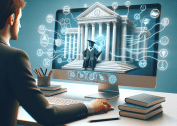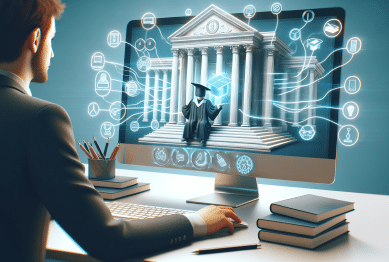Explore surprising developments in online education and how digital classrooms are changing society. This detailed guide covers new approaches, evolving student support, accessibility breakthroughs, and the impact of technology on lifelong learning.
Rethinking Digital Classrooms and Online Access
With the rapid evolution of technology, digital classrooms have become a central part of modern education. Many institutions now invest heavily in platforms that allow students to access materials, lectures, and resources from anywhere. High-speed internet and cloud services make it easier for learners to engage, especially for those in remote or rural communities. This transformation is helping to bridge educational gaps that previously limited opportunities for students outside traditional urban centers. Mobile accessibility further ensures that students can participate in learning even if they lack personal computers.
Online education also promotes a new kind of flexibility, allowing learners to set their own pace and tailor their schedules to personal needs. For working adults, parents, or those with unique learning requirements, this means education can now fit around existing responsibilities rather than impose rigid timetables. Self-paced modules and interactive content give students choices in how and when they consume information, helping to promote deeper engagement and retention of lessons.
Access remains a challenge for some, particularly in areas with limited internet connectivity or outdated infrastructure. However, there are ongoing efforts by governments, nonprofits, and private sector organizations to improve broadband reach and provide devices to underserved communities (see example programs by U.S. Department of Education and initiatives like ConnectHome). Improvements in online learning environments have increased digital literacy, a key skill for both educational and workforce development. Accessibility features such as transcripts and screen readers make learning more inclusive for students with disabilities.
Adaptive Learning Systems and Personalized Pathways
Adaptive learning has redefined what it means for education to be student-centered. These systems analyze student performance and tailor content delivery to each learner’s strengths and weaknesses. As a result, online platforms can provide quizzes, interactive modules, and even AI-powered recommendations that adjust in real-time based on a student’s progress. This personalization helps to reduce frustration and encourages deeper mastery of complex subjects.
Major universities and edtech firms now collaborate on adaptive technologies, sharpening the ability to serve diverse populations. For example, platforms deployed by large projects in states like California have improved outcomes for students who previously struggled in standard lecture formats (see UCLA’s research on personalized digital tools). By offering immediate feedback and targeted practice, adaptive systems promote continuous growth, making it easier for learners to revisit trouble spots and skip ahead where confident.
Personalization doesn’t just mean faster progression for advanced students. It opens doors for those with learning differences, language barriers, or gaps in prior preparation. Data-driven instruction tailors support, boosting retention and motivation across all backgrounds. The flexibility to set one’s own pace without feeling left behind or waiting for others has profound effects on both confidence and educational achievement.
The Rise of Microcredentials and Skills Badges
Microcredentials and digital badges are changing the way students demonstrate learning and skills. Unlike traditional degrees that can take years to complete, these new forms of certification allow learners to prove competency in specific areas quickly. Leading universities, companies, and workforce organizations have created short, focused programs in fields such as data analytics, digital marketing, project management, and more. Employers often recognize these digital credentials, appreciating their clear evidence of particular skills.
Microcredentials offer a practical solution for people seeking career advancement, career changes, or upskilling without returning to full-time study. This pathway is especially valuable for adult learners, who may already possess substantial work experience but need proof of expertise in new domains. New partnerships between major universities and platforms like edX or Coursera help deliver these certified programs at scale, further increasing accessibility and relevance.
As the world moves toward a skills-based economy, the recognition and portability of these digital achievements make education more responsive to labor market demands. Skills badges appear on professional profiles, resumes, and social networks, making it easy for recruiters to verify and match candidates. This trend not only benefits individuals but also helps employers identify talent more efficiently, promoting equity in hiring and broadening access to opportunity.
Supporting Mental Health in Online Environments
Mental health and wellness have become major focal points for distance learning strategies. Prolonged online study and social isolation have presented new challenges, especially for those lacking support systems. In turn, schools now incorporate virtual counseling, peer support groups, and digital mindfulness programs. Many platforms implement anonymous chat services and regular mental health check-ins to support student well-being in these virtual learning environments (see initiatives at institutions like University of Michigan).
Increased awareness and accessible counseling services help to reduce stigma around mental health concerns, encouraging students to seek help proactively. Online workshops on managing stress, building routines, and coping with digital fatigue are commonplace. These resources provide easy ways to connect with professionals and peers even from home, creating a network of support that complements academic programs.
Mental wellness now goes hand-in-hand with academic success. Schools and universities integrate social-emotional learning frameworks and offer personalized support tailored to diverse populations. These efforts build resilience and community, laying the foundation for long-term success both in school and later in the workforce. As a result, the online learning experience is becoming more holistic, reflecting the needs of modern students.
How Technology Shapes Lifelong Learning Trends
Lifelong learning has emerged as a necessity in today’s job market, fueled by technological advances and shifting industry needs. Online education platforms help people stay current with new knowledge, whether for personal growth, career advancement, or even retirement transitions. The accessibility of open online courses has removed barriers for learners of all ages and backgrounds, democratizing education at a global scale (see MIT OpenCourseWare and UNESCO reports).
The modular structure of many online programs enables individuals to study bit by bit, aligning with shifting schedules and personal goals. From learning a new language to developing advanced STEM skills, opportunities abound at every stage of life. Programs like Google’s Grow with Google and other digital literacy initiatives highlight the increasing importance of upskilling for everyone, not just recent graduates or young professionals.
Community-driven resources and mentorship opportunities create networks for learners to share ideas, ask questions, and collaborate on projects. As more institutions open their libraries, lectures, and even live events to the public, the lines between formal and informal education blur. This open approach not only nurtures curiosity but also encourages lifelong growth well beyond school years.
Closing Digital Divides and Building Equitable Futures
Despite major progress, the digital divide remains a critical issue for online learning equity. Some students still lack affordable devices or reliable connectivity. Addressing these gaps is the focus of government initiatives, university outreach programs, and technology partnerships worldwide. Community-based training in digital literacy ensures that everyone, regardless of background or income, has the opportunity to participate in the digital economy.
Policies that encourage universal design, provide multilingual resources, and invest in localized content help make education inclusive for multicultural populations. Programs targeting underserved groups, such as first-generation students and rural learners, are expanding access by removing practical barriers. Nonprofits and international coalitions help drive these changes, working to ensure that every learner has the support needed to thrive online (see UNICEF’s digital inclusion efforts and U.S. Department of Education digital equity campaigns).
True educational equity relies on a combination of policy, private sector innovation, and persistent advocacy. By addressing infrastructure, affordability, and social factors, these collective efforts shape futures where no one is left behind. As these strategies become standard, the promise of online learning is more fully realized for millions around the globe.
References
1. U.S. Department of Education. (n.d.). Reimagining the Role of Technology in Education. Retrieved from https://tech.ed.gov/netp/
2. ConnectHomeUSA. (n.d.). Connecting Communities. Retrieved from https://connecthomeusa.org/
3. University of California, Los Angeles (UCLA). (n.d.). Personalized Learning in the Digital Age. Retrieved from https://centerx.gseis.ucla.edu/research-and-impact/personalized-learning/
4. University of Michigan Student Life. (n.d.). Mental Health and Well-being in Online Learning. Retrieved from https://studentlife.umich.edu/article/mental-health-and-well-being-online-learning
5. Massachusetts Institute of Technology (MIT). (n.d.). MIT OpenCourseWare. Retrieved from https://ocw.mit.edu/
6. UNICEF. (n.d.). Digital Learning and Inclusion. Retrieved from https://www.unicef.org/education/digital-learning-and-inclusion









